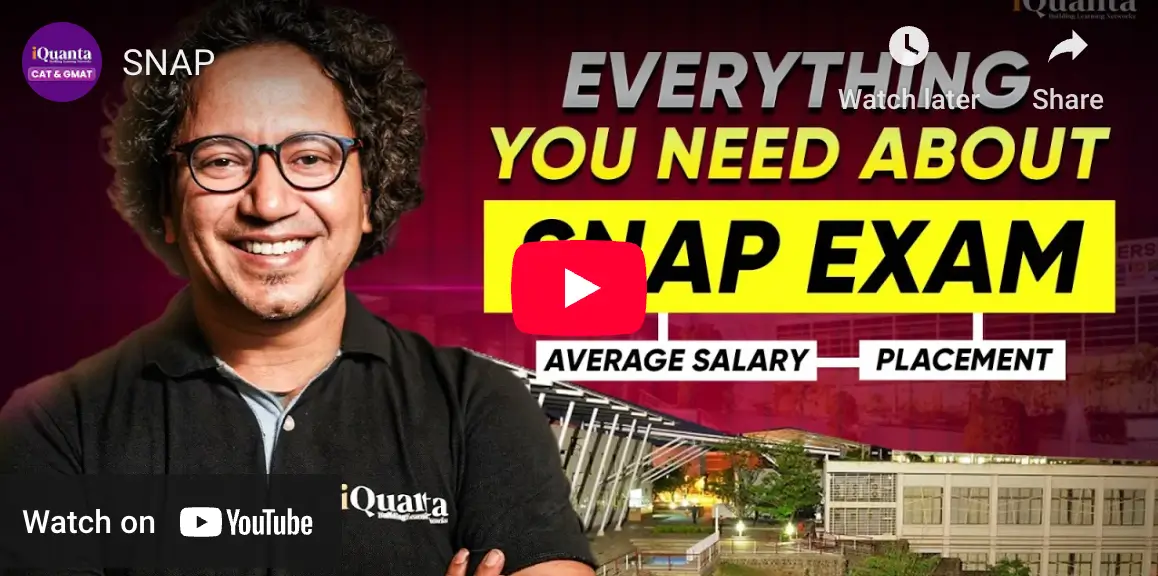Best SNAP Online
Coaching - iQuanta
40,000 Top B-School calls in just 5 years
SNAP 2025 Courses
SNAP Mock Test Series
SNAP Doubt Group
3.5 Lakh+ Members

SNAP 2025 Courses
SNAP Mock Test Series
SNAP Doubt Group
3.5 Lakh+ Members






iQuanta SNAP Topper’s Feedback


















 iQuanta SNAP 2025 Packages
iQuanta SNAP 2025 Packages Free Counselling
Free Counselling
iQuanta SNAP Course Feedback






















SNAP 2025 Flagship Courses
Everything about SNAP 2025
01
What is an MBA?
MBA or Masters of Business Administration is a Postgraduate degree highly valued in the market. An MBA programme aims to impart a holistic knowledge in the field of Management under Finance, Marketing, Human Resources, Operations and several other domains.
Why MBA?

- Industry Knowledge
- Higher Earnings
- Personality Development
- Better Job Profile
- Networking
- Career Switch
02
Colleges Accepting SNAP Scores:
Conducting Boady:
Top SNAP Colleges
- SIBM, Pune
- SICSR, Pune
- SCMHRD, Pune
- SIIB, Pune
- SIDTM, Pune
- SIMS, Pune
- SIMC, Pune
- SIOM, Nashik
- SCIT, Pune
- SIHS, Pune
- SIBM, Bengaluru
MBA colleges Accepting SNAP Score:
SIBM Pune, SCMHRD Pune, SIBM Bangalore, SIIB Pune, etc
B-School Packages
- SIBM Pune: 26.77 LPA
- SCMHRD Pune: 23.71 LPA
- SIIB Pune: 13.12 LPA
- SIBM Bangalore: 13.48 LPA
- SIOM Nashik: 12.38 LPА
| GENERAL PACKAGES | ||
| TOP 5 B-Schools | 12+ LPA | |
| TOP 10 B-Schools | 9+ LPA | |
| TOP 15 B-Schools | 6+ LPA | |
- SIBM Pune

- SCMHRD Pune

- SIBM Bangalore

03
SNAP EXAM PATTERN
SNAP Question paper contains total of 60 questions which are to be solved within 1 hour(60 minutes).
subject
- GENERAL ENGLISH
- ANALYTICAL AND LOGICAL REASONING
- QUANTITATIVE, DАТА INTERPRETATION
questions
- 15
- 25
- 20
60 Total
time
- 60
minutes
Question Type: Multiple Choice Questions.
MARLING SCHEME : Each correct answer earns +1 mark, while for each incorrect answer, -0.25 marks are deducted.
04
SNAP 2025
IMPORTANT DATES
| EVENTS | SNAP 2025 DATES |
| SNAP 2025 Registrations | Aug - Nov 2025 |
| SNAP 2025 admit card download for session 1 | Dec '2025 |
| SNAP 2025 session 1 | Dec '2025 |
| SNAP 2025 session 2 | Dec '2025 |
| SNAP 2025 session 3 | Dec '2025 |
| SNAP 2025 result announcement | Jan '2026 |
| SNAP 2025 admit card -session 2 and 3 | Dec '2025 |
05
SNAP ELIGIBILITY
Here are the minimum academic requirements for basic eligibility for the SNAP in 2025:
Criteria:
- Candidate should be a graduate from any recognized University/ Institution of National Importance and must have obtained a minimum of 50% marks or equivalent grade.
- 45% marks or equivalent grade for Scheduled Castes/ Scheduled Tribes.
- Final year students can also apply, their admission will also be subjected to the grades mentioned above.
- There is no age limit on appearing for SNAP, but since the minimum qualification is graduation, candidates have to be at least 18 years and above.
SNAP 2025 Syllabus
General English Syllabus & Weightage for SNAР
| THE MOST IMPORTANT TOPICS (in terms of weightage) | |||
|---|---|---|---|
| Topics | Expected Number of Questions | ||
| Vocabulary | 6 | ||
| Grammar | 8 | ||
| Others( poem based) 1 | 1 | ||
LR Syllabus & Weightage for SNAP:
| Topics | Expected Number of Questions |
|---|---|
| Sequential Output | 1 |
| Syllogisms | 1 |
| Statement and course of action | 2 |
| Critical Reasoning | 3 |
| Cause-effect | 1 |
| Statements and assumptions | 1 |
| Family Tree | 2 |
| Odd man out | 1 |
| Word arrangement | 2 |
| Complete the series | 2 |
| Clocks | 2 |
| Calendars | 2 |
| Linear Arrangements | 2 |
| Coding | 2 |
| Numerical Puzzle | 1 |
| Total | 25 |
SNAP Quant Syllabus & Weightage
| Topics | Expected Number of Questions |
|---|---|
| Modern Maths | 4 |
| Arithmetic | 7 |
| Numbers | 2 |
| Geometry | 4 |
| Data interpretation | 1 |
| Algebra | 2 |
| Total | 20 |
SNAP 2025 Exam Preparation Strategy
The Symbiosis National Aptitude Test (SNAP) is a crucial gateway for admission into the prestigious Symbiosis International University (SIU) and its affiliated institutes. As an aspirant aiming to excel in the SNAP exam, it's essential to have a well-rounded preparation strategy that covers all sections of the syllabus. This guide provides a detailed approach to tackling each section of the SNAP exam effectively.
Exam Format:
Mode: Computer-Based Test (CBT)
Duration: 60 minutes
Total Questions: 60
Sections:
General English (15 questions)
Analytical & Logical Reasoning (25 questions)
Quantitative, Data Interpretation & Data Sufficiency (20 questions)
Marking Scheme:
Correct Answer: +1 mark
Incorrect Answer: 0.25 mark
Total Questions:Total Questions: 60
No negative marking for unattempted questions.
A. General English
The General English section in SNAP evaluates candidates on their command over the English language, including grammar, vocabulary, comprehension, and verbal ability.
Key Areas to Focus:
Vocabulary: Questions can involve synonyms, antonyms, idioms, and phrases. A strong vocabulary helps in direct vocabulary questions and enhances comprehension abilities.
Grammar and Sentence Correction: This involves identifying errors in sentences, improving sentence structures, and understanding the rules of grammar.
Verbal Logic: This includes questions on para jumbles, sentence completion, and odd sentence out.
Preparation Tips:
- Reading and Comprehension Practice: Regularly read diverse materials such as articles, essays, and editorials. Utilize resources like iQuanta's Free CAT Study Material which offers a vast collection of articles with summaries to enhance reading speed and comprehension skills.
- Vocabulary Building: Utilize flashcards, vocabulary apps, and word lists to steadily build and review vocabulary. You can be part of iQuanta Community where important word list will be shared
- Grammar Review: You can enrol for iQuanta NMAT-SNAP course where we will have more than 60 hours of classes for Verbal ability section which includes more than 30 hours of live classes for english grammar. Check details
- Practice Previous Year Papers: Regularly solve SNAP previous year papers to understand the pattern and difficulty level. Resources like iQuanta’s SNAP Previous Papers can be invaluable.
Strategy During the Exam:
Quick Vocabulary and Grammar Questions: Move swiftly through vocabulary and grammar questions, leveraging your preparation to answer these accurately in minimal time.
Manage Time Efficiently: Allocate time judiciously across different question types to ensure you cover all aspects of the section. Try to Complete VA section in 6-7 Minutes
B. Analytical & Logical Reasoning
This section tests logical thinking, problem-solving ability, and data analysis skills. It includes puzzles, critical reasoning, and various forms of logical reasoning questions.
Key Areas to Focus:
Analytical Reasoning: This involves solving puzzles, seating arrangements, blood relations, and direction sense problems.
Logical Reasoning: - Questions on syllogisms, analogies, logical sequences, and statement-conclusion are common.
Critical Reasoning: This includes arguments, assumptions, cause and effect, and course of action.
Preparation Tips:
- Conceptual Clarity: If you enrol for iQuanta NMAT-SNAP course, as soon as you will enrol you will get access to 400+ Conceptual videos and with the help of that you can cover your basic concepts. Check details
- Regular Practice: Daily practice of puzzles and reasoning questions is essential. Use platforms like iQuanta for a variety of reasoning problems and solutions.
- Mock Tests and Timed Practice: Regularly take mock tests to improve speed and accuracy. Time-bound practice sessions help in developing quick problem-solving techniques under exam conditions
- Analyze Mistakes: Review and analyze mistakes in mock tests and practice sessions to avoid them in future attempts.
Strategy During the Exam:
Start with Familiar Topics: Begin with questions you are confident about to secure quick points.
Skip Time-consuming Questions: - Identify and temporarily skip complex puzzles or reasoning questions that are time-consuming, revisiting them if time permits.
Logical Approach: Use logical elimination and step-by-step analysis for solving puzzles and critical reasoning questions.
C. Quantitative, Data Interpretation & Data Sufficiency
This section assesses mathematical ability, data interpretation skills, and understanding of data sufficiency. The questions range from basic arithmetic to higher-level quantitative problems.
Key Areas to Focus:
Quantitative Aptitude: Covers topics like arithmetic, algebra, geometry, number systems and probability.
Data Interpretation (DI): Includes analysis of data through charts, graphs, and tables. Questions test the ability to interpret and derive insights from data sets.
Data Sufficiency: Questions require determining whether provided data is sufficient to answer a question.
Preparation Tips:
- Fundamental Concepts
- Speed and Accuracy: Practice speed maths techniques and shortcuts to improve calculation speed. Resources like Vedic Maths can be beneficial for fast calculations.
- Regular DI Practice: 3. Solve various types of DI sets regularly. Focus on understanding different types of graphs and charts and practice deriving insights quickly.
- Mock Tests and Previous Papers: Regularly solve SNAP mock tests and previous year papers to familiarize yourself with the exam pattern and question types. Utilize resources like iQuanta’s Free CAT Study Material for practice questions.
Strategy During the Exam:
Start with Strong Areas: Begin with topics you are most comfortable with to build confidence and secure early marks.
Balance Speed and Accuracy: - Maintain a balance between speed and accuracy, especially in DI and complex quantitative problems.
Eliminate Options: Use the process of elimination for data sufficiency and quantitative questions when possible.
A. General Knowledge and Current Affairs
Though not a primary section in SNAP, keeping updated with current affairs and general knowledge can be beneficial, especially for interviews and group discussions post-exam.
Preparation Tips:
Daily News Updates: Regularly read newspapers, magazines, and online news portals to stay updated on current affairs.
Weekly Reviews: - Summarize weekly news highlights and review them periodically.
Quiz and Practice: Engage in GK quizzes and practice questions on platforms like iQuanta to test your knowledge.
B. Time Management and Stress Handling
Efficient time management and stress handling are critical to performing well in the SNAP exam.
Tips
- Mock Tests: Regularly take full-length mock tests under exam conditions to improve time management skills.
- Sectional Timing: Develop a strategy for the time allocation for each section during the exam.
- Stay Calm and Focused: 3. Practice relaxation techniques and maintain a positive mindset to handle exam stress effectively.
C. Mock Tests and Analysis
Regular Mock Testing
Take at least 10 full-length mock tests to simulate the actual exam environment.
Use resources like iQuanta’s SNAP Mock Tests for realistic practice.
Detailed Analysis:
Analyze each mock test to identify strengths and areas for improvement.
Focus on understanding the mistakes and learning from them to avoid repetition.
Cut-off Trends:
Understanding the cut-off trends for SNAP is crucial for setting realistic score targets and planning your preparation strategy accordingly.
The overall and sectional cut-offs can vary each year based on the difficulty level and competition.
Generally, aim for a balanced score across all sections to meet both overall and sectional cut-offs for your desired programs.
Sectional Strategy:
Allocate time proportionally to each section based on your strengths and weaknesses.
Ensure you meet the sectional cut-offs by giving adequate focus to all sections during preparation and the actual exam.
Preparing for the SNAP exam requires a well-rounded approach covering all sections comprehensively. Focus on building strong fundamentals, practicing regularly, and developing effective time management strategies. Utilize resources like iQuanta’s SNAP Preparation Course for structured guidance and practice materials.
Remember, consistent practice and a positive mindset are key to excelling in the SNAP exam. Approach the preparation with determination and confidence, and you’ll be well on your way to securing admission to one of the top B-schools under Symbiosis International University.
iQuanta‘s SNAP 2025 Free Resources
paid

01
400+ Pre recorded Conceptual Videos02
150+ Hours of live Class03
4000+ Practice Questions(Topic Wise)04
SNAP Full Mocks 1005
24*7 Doubt Solving06
SNAP Specific Sessions07
SNAP Specific VA Sessions for Grammar and Vocabulary08
Special Initiatives by Indrajeet Singh iQuanta
free
01
SNAP Quant Formula Book02
02. Doubt Solving Group03
SNAP Resources04
SNAP Exam Pattern05
SNAP Syllabus and Strategy06
Download MBA Brochure07
iQuanta Youtube Channel08
Free SNAP Specific Practice Session
Everything Included in SNAP 2025 Course
iQuanta‘s SNAP 2025 Resources
01
Conceptual live Stream Classes 80+ Hours02
15+ Practice Session03
iQuanta Exclusive Material (Per Topic 50 | Total 5000 Quesions)04
SNAP Full Mocks 705
24*7 Doubt Solving06
SNAP Specific Intensive DI Sessions07
SNAP Specific VA Sessions for Grammar, Poems and Vocabulary08
SNAP Specific 100+ Decision making Sets with Video Solution09
Special Initiatives by Indrajeet Singh iQuanta
Everything Included in SNAP 2025 Course
01
SNAP Past Year Papers02
Doubt Solving Group03
SNAP LRDI Resources04
SNAP level Question Bank05
Download Formula Book06
Download SNAP Brochure07
Download MBA Brochure08
iQuanta Youtube Channel09
SNAP Specific CR & PJ for Practice10
SNAP 150 & DM session by Indrajeet singh.
- Call Us: 8035227668
- Contact for Franchises: 9458123637
- Mail: info@iquanta.in
- Address: Ground Floor, 126, Udyog Vihar Phase 4 Rd, Phase III, Udyog Vihar, Sector 19, Gurugram, Haryana 122022
Which CAT Mock Test Series to Choose?
Latest CAT Mock Strategy 2025
Importance of Mock Tests for CAT 2025
Wasting Your Time on Mock Analysis? Get the CAT Mock Analysis Within Minutes
© 2025 iQuanta. All Right Reserved. Website is governed by Indian law.
- Home
- Mocks
- Past Papers
- Result
- CATOMET
- NMAT + SNAP 20 Full Mocks
- NMAT 10 Full Mocks
- SNAP 10 Full Mocks
- XAT 7 Full Mocks
- IIFT 5 Full Mocks
- MICAT 5 Full Mocks
- CMAT 7 Full Mocks
- CUET PG 7 Full Mocks
- MHCET 7 Full Mocks
IPMATNEETIIT JEE
- Terms and PoliciesReach out to us
Get your questions answered about learning with iQuanta
- Call: 8035227668
- Ground Floor, 126, Udyog Vihar Phase 4 Rd, Phase III, Udyog Vihar, Sector 19, Gurugram, Haryana 122022
- Follow us at:

